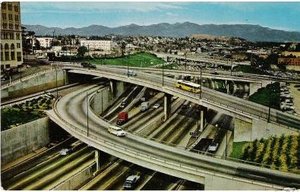California State Route 110
|
|
Template:RouteboxcaCalifornia State Route 110 extends from California State Route 47 in San Pedro, California to Glenarm Street in Pasadena, California, USA. Most of Route 110 south of Interstate 10 is designated Interstate 110; the southernmost section is again signed as a state route. Route 110 is 33 miles (53 km) long; Interstate 110 is 20.5 miles (33 km) long. The portion of Route 110 north of U.S. Highway 101 is called the Pasadena Freeway. The portion south of Highway 101 is called the Harbor Freeway.
| Contents |
Pasadena Freeway
A nine-mile (14 km), dedicated cycle-way was built in 1897 to connect Pasadena to Los Angeles. Its right of way followed the stream bed of the Arroyo Seco and required 1,250,000 board feet (2,950 m³) of pine wood to construct. The roundtrip toll was US$.15 and it was lit with electic lights along its entire length. The route did not succeed, and the right of way later became the route for the Arroyo Seco Parkway. [1] (http://www.fhwa.dot.gov/infrastructure/the_great_cycle_way_.htm)
The original freeway was first named the Arroyo Seco Parkway. It had no highway number designation when it first opened and originally had a speed limit of 45 miles an hour (70 km/h). Traffic originally ran in two lanes in each direction with a wide shoulder available for emergency parking. The original route of this Parkway - its 1940 appellation - ran from downtown Los Angeles to Pasadena. It was the first freeway ever built in the United States, completed in 1940, and was considered a modern engineering marvel at the time. Nowadays, the roadway is considered outdated and dangerous by today's standards; for example, motorists must merge with oncoming traffic almost immediately upon entering the freeway and in its current three lane in each direction configuration, the right shoulders are very narrow making it very dangerous to make an emergency stop in case of tire puncture and other vehicle problems. Additionally, many of the onramps in the South Pasadena area require the driver to stop before merging onto the Pasadena Freeway. Despite the risks, this freeway remains heavily used.
Four medium-sized tunnels (called the "Figueroa Street Tunnels") run under and through the hills of Elysian Park.
The Pasadena Freeway runs through heavily working-class Latino neighborhoods such as Lincoln Heights and Highland Park, as well as upper-middle-class white populated portions of Pasadena and South Pasadena. (Information based on Census data.)
Extension of route
Since its original opening, the freeway has been extended southwards from the four level interchange near downtown Los Angeles to the port of Los Angeles, in San Pedro. The Harbor Freeway runs through the poorer inner-city sections - with a predominant African American population - of South Central Los Angeles. The Harbor freeway is entirely within the city of Los Angeles except a four-mile stretch where it marks the boundary between Carson, California and an unincorporated area in the South Bay. This section of freeway is much wider and safer than the original Pasadena to Los Angeles route.
Landmarks and filmography
Some famous landmarks along or nearby the Interstate 110 Harbor Freeway include the University of Southern California (USC), Los Angeles Memorial Coliseum, Shrine Auditorium (where several major film, TV, and music awards are presented), Staples Center (home of the NBA's Los Angeles Lakers and Clippers and NHL's Kings), Chinatown, Dodger Stadium (home of the MLB's Los Angeles Dodgers ), and the Southwest Museum (a museum dedicated to Native American culture).
Tucked within the southwest loop of the intersection with Interstate 10 is the Central Los Angeles office of the California Highway Patrol. It was heavily photographed for the 1970s U.S. television program CHiPs, as it was depicted as the home office of its main characters, Officers Jon Baker and Frank Poncherello. It does not have direct access to or from either freeway, though.
During the 1992 Los Angeles riots, a white truck driver named Reginald Denny was pulled from his truck and beaten on an intersection, Florence Avenue and Normandie Street, about a mile (2 km) west from the 110 Freeway. The incident was broadcast live via news helicopter.
The Pasadena Freeway can be seen in the introduction of the 1971 Steven Spielberg film, Duel. Dennis Weaver's character drives through several tunnels before entering the Interstate 5 interchange (which leads to Sacramento and beyond).
Citizen involvement
In 2001, Richard Ankrom, a local artist, who repeatedly got lost trying to get onto Interstate 5 North from the 110 Freeway because there was no clear official signage labeling access to the 5 North, solved his frustration by covertly modifying one of the overhead signs on the freeway just before the tunnels. Using official government sign specifications, Ankrom fabricated two sign pieces, one being an Interstate marker shield with the number '5' on it, and one with the word "NORTH", and affixed them to the left side of the sign. The unofficial modifications remain on the sign to this day, after having been inspected by CalTrans to ensure it would not fall off onto the road below. CalTrans is gradually upgrading all California freeway signs to a newer, more reflective form; when this happens on the 110, Ankrom's work will be lost, but the new sign will include "5 North" icons.
Ankrom was never charged, despite statements from officials that his actions were illegal.
See also
External links
- Arroyo Seco Parkway preservation site (http://www.nationaltrust.org/magazine/archives/arc_news/061803.htm)
- A textual account of Ankrom's sign modification (http://www.laweekly.com/ink/02/25/a.php)
- Cahighways.org article on the 110 freeway (http://www.cahighways.org/105-112.html#110)
- California's Great Cycle-Way (http://www.fhwa.dot.gov/infrastructure/the_great_cycle_way_.htm)Template:California State Highway Stub


